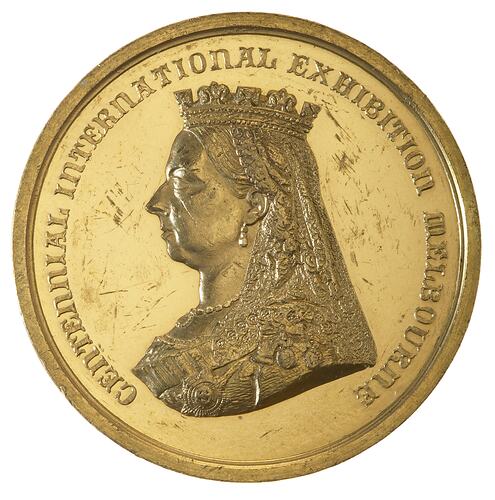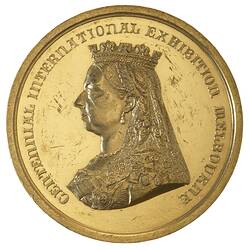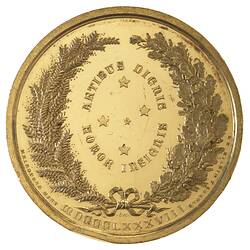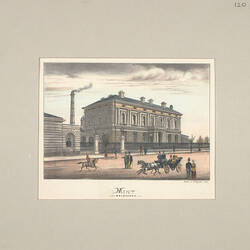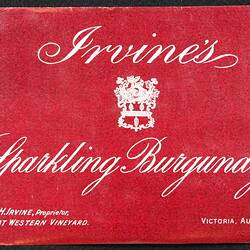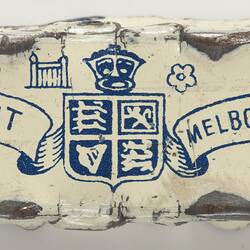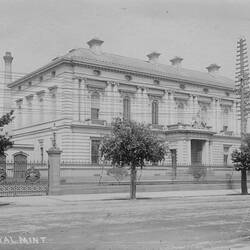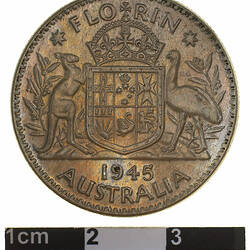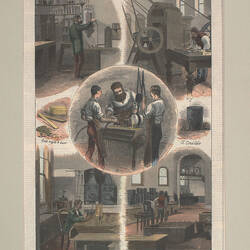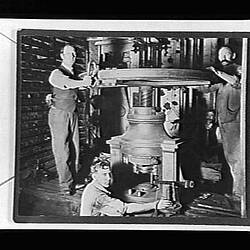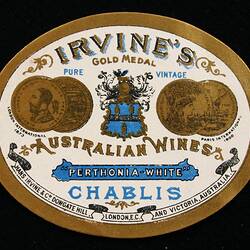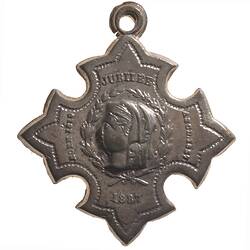Summary
Medal awarded to Hans W.H. Irvine at the 1888 Centennial International Exhibition, Melbourne.
The Exhibition, celebrating a century of Australian settlement, surpassed even the grand scale of the1880 Melbourne International Exhibition. It attracted over two million people, but the Victorian government had to spend £250 000 on it, ten times the amount estimated. The exhibition had a distinctively imerial focus, and a greater emphasis on culture than in 1880, particularly on music and painting. A choir of five thousand sang music old and new, and half a million people attended symphony concerts. There were over three thousand paintings on display, including works by artists like J.M.W. Turner and C. Lutyens. The Exhibition Building in Carlton Gardens was lit inside and out by electric lights, claimed to be the largest installation of arc lighting in the world.
On 28 May 1888 the Executive Commissioners for the Melbourne Centennial International Exhibition advertised a competition for the design of a medal and certificate to be given to exhibition prize-winners. A payment of 100 guineas would be given to the winner in each category. The medal designs were to be modelled in relief, and the designs for the certificate to be drawn in Indian ink. The medal was to show the Queen's head in profile on the obverse, and a 'suitable design' on the reverse. Nineteen designs for the medal were received, and 52 designs for the certificate. A sub-committee from the Fine Arts Committee was appointed to select the winners, and on 18 Jaunary Ernst A. Altmann, a Melbourne die-sinker and engraver, was selected as the winner of the medal design and Mrs Mary Stoddard the winner of the certificate design.
The Royal Mint was asked to strike the medal, but Deputy Master George Anderson reported that some of the relief was almost undercut, requiring unusual pressure, and was not feasible. This had hapenned to Altmann before, when his winning medal design for the 1880 exhibition was also rejected. Altmann was too unwell to re-work his design, so George Anderson was asked to both design and execute the medal. The dies were to be engraved by Stokes & Martin. Anderson set to work, and produced a medal that featured the Queen's head on the obverse, based on the Jubilee medal by Sir Joseph Edgar Boehm, except that the crown had been replaced by a 'more firmly seated one which is seen inthe New Zealand war medal'. On the reverse he provided a wreath composed of the leaves and acorns of British oak and the leaves and acorns of the wattle. The oak and wattle were tied together 'by a true-lover's knot, 'symbolizing the unity and affection between the mother country and the colony'. The motto 'Artibus dignis, honor insignis' - meaning 'to the deserving arts, distinguished honour' - was placed within the wreath, encircling the Southern Cross.
The medals were minted in gold, silver and bronze, in 1-1/2", 2" and 3" in diameter respectively. The first medal was presented to Governor Sir H. B. Loch on the day of his departure from Victoria, on 15 November 1889, 10 months after the close of the Exhibition.
Hans William Henry Irvine, born in Melbourne in 1856, was a successful vigneron and politician, and was known as the 'wine king of Australia'. His largest holding was the Great Western winery, which he owned from 1888-1918. In the early 1890s Irvine purchased two-thirds of the produce of local vignerons, much of which was distilled into his brandy. He also became known for his claret, hock, chablis, burgundy, hermitage, sparkling hock and sparking burgandy. He was an effective self-promoter, and in 1982 entertained the Victorian governor in lavish style. He also pioneered wine advertising. Irvine was particularly interested in the science of wine-making, and used the latest technologies in his cellars. These contributed to his success at a time when so many other Victorian wine-makers were struggling.
In 1892 he was commissioned by the Victorian minister of agriculture to write a report on the Australian wine trade. Two years later he suggested a conference of vignerons to discuss problems facing the industry, and supported the proposal for a college of viticulture and the introduction of phylloxera-resistant American root stocks. He encouraged industry self-regulation through an elected board, the establishment of regional wineries and cheaper finance for investors in the wine industry. He travelled to Europe several times to learn wine-making techniques and arrange sales.
"The Irvine Wine Collection was acquired by Museum Victoria in 1989. It represents the history of the Great Western Vineyard and the achievements of Hans William Henry Irvine, vigneron and politician, from 1888 until 1922. It comprises 130 items ranging from publications, marketing items, packaging materials, wine labels, award medals, ceramics, illuminated address, commemorative trowel, trophy plaques, wine makers tools, and silverware."
Physical Description
The gold medal of the Centennial International Exhibition featuring a bust of Queen Victoria facing left wearing crown and veil and a Victor's wreath of wattle and oak around the Southern Cross and the motto in Latin "To the deserving arts, distinguished honour"
Obverse Description
Head of Queen Victoria, wearing crown and veil left; around, CENTENNIAL INTERNATIONAL EXHIBITION MELBOURNE
Reverse Description
Within a wreath of wattle and oak branches the Southern cross and the oval legend, ARTIBUS DIGNIS HONOR INSIGNIS; below the date MDCCCLXXXVIII; in tiny letters each side of date, MELBOURNE MINT STOKES & MARTIN SC.
Edge Description
HANS IRVINE
Significance
Exhibitions in Melbourne became a regular occurrence from the middle of the nineteenth century, becoming grander and larger each time. The 1888 Centennial International Exhibition, celebrating a century of Australian settlement, surpassed even the grand scale of the1880 Melbourne International Exhibition. It had more British and imperial resonance. It attracted over two million people, but the Victorian government had to spend £250 000 on it, ten times the amount estimated. The sum seemed absurd after the economic boom came to an end in 1889. There was a greater emphasis on culture than in 1880, particularly on music and painting. A choir of five thousand sang music old and new, and half a million people attended symphony concerts. There were over three thousand paintings on display, including works by artists like J.M.W. Turner, C. Lutyens and Frederic Leighton. The building was lit inside and out by electric lights, claimed to be the largest installation of arc lighting in the world. -REB World Heritage Nomination, Environment Australia, 2002; Official Record of the Centennial International Exhibition. -D. Tout-Smith 23/10/2003.
More Information
-
Collection Names
-
Collecting Areas
-
Acquisition Information
Purchase
-
Date Issued
1888 AD
-
Issued By
Exhibition: 1888 Centennial, Melbourne, Melbourne, Greater Melbourne, Victoria, Australia, 1888
-
Mint
Melbourne Branch of Royal Mint, Melbourne, Greater Melbourne, Victoria, Australia, 1888
-
Designer
George Anderson - Royal Mint, Melbourne, Melbourne, Greater Melbourne, Victoria, Australia, 1888
-
Engraver
Stokes & Martin (Mint), Melbourne, Greater Melbourne, Victoria, Australia, 1888
-
Awarded To
Mr Hans W. Irvine - Great Western Vineyards & Champagne Cellars, Great Western, Victoria, Australia, 1888
-
Person Depicted
-
Inscriptions
Edge: HANS IRVINE Obverse: CENTENNIAL INTERNATIONAL EXHIBITION MELBOURNE Reverse: ARTIBUS DIGNIS HONOR INSIGNIS MDCCCLXXXVIII; in tiny letters each side of date, MELBOURNE MINT STOKES & MARTIN SC.
-
Series
-
Material
Gold
-
Axis
12
-
Classification
-
Category
-
Discipline
-
Type of item
-
Overall Dimensions
39 mm (Outside Diameter), 45.012 g (Weight)
-
Shape
Round
-
References
Car. 1888/8 in gold
-
Keywords
